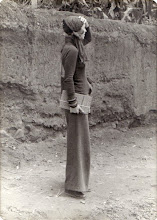Since it became widely available, photography has grown and spread exponentially, much more rapidly than other media. Painting, for instance, eked out a purist and somewhat aesthetically sterilizing period when modernism recognized art for its own sake, despite a paradigm shift in its approach, before exploding into a series of co-existing though linear post-modern movements. Perhaps due to its aspect of mechanical reproduction, or because it stood on the shoulders of giants from its inception, or simply because it was never a traditional form, photography as art has evolved into a multidimensional, nonlinear cloud of disparate styles and methods as it moved past its 'modernist' phase into postmodernism and post-postmodernism. In what was considered a seminal turn in the 1960s by those of the Pictures Generation, Cindy Sherman, Richard Prince, Troy Brauntuch and the like moved away from the straight shot, non-coded use of photography as described by Roland Barthes and into the re-presentation of appropriated images reflecting on their place in society and reflected on how their message was constructed.
(N.B. old dogs, new tricks? Walker Evans took nearly 3,000 polaroids in the last year of his life, 1975, with a new fervor, looking at his classic themes of portraits like the one appropriated by Levine, road signage, domestic interiors and buildings, yet after Sherrie Levine's work, takes on a post-post-modern aspect). [essay on his "counter-aesthetic]
Looking back now, and as was done in the various re-staging of Pictures shows at Artists Space and elsewhere, even those first postmodernists seem amazingly similar when faced with the incredible variety of styles and methods today. Just looking at portraiture, the current show at the Smithsonian is showing a handful of artists who demonstrate the broadness of the spectrum. From Katy Grannan's poignant images of the quotidian, to Alec Soth's fine line between fine art and fashion editorial, to Ryan McGinley's close observation and active participation in music culture, it remains clear that postmodern photography if anything defines itself in variety and a lack of a visual, aesthetic, methodical or theoretical unifying trait.

Katy Grannan
 Ryan McGinley
Ryan McGinley(other N.B.: I think I'm on Dave Hickey's - and Marla Rutherford's - and so many others' side on getting into the work, giving oneself to the subject or finding it within in order for it to transcend the medium - not in the non-coded sense but in sense that makes it fine art - and that's something I think adds to the value of Ryan McGinley's work, in both an aesthetic and social sense.)
For an example of the diversity and non-linearity of photography, themes such as the black body politic have been addressed in as many ways as there are photographers - from the sexualized, individualized portraits by Mapplethorpe and the re-presentation of Civil Rights Movement archival images by Jeff Wall, all challenge the ideas and perceptions embedded in their creation and associations, unpacking the history of the subject and the treatment by the camera, and often questioning their tenuous relationship with art world valuation. It's interesting to continue to look at the work of those like Zoe Leonard, Renée Green and Glenn Ligon to see how these questions are brought to new levels of post-postmodernism.http://www.diacenter.org/ligon/ Glenn Ligon



Renée Green, appropriating Robert Smithson
There's no conclusion, nor any satisfaction for me at least, in trying to create a linear understanding of such a non-linear medium - if anything, I end this post anxiously wanting to add dozens and dozens of artists' whose works seem to fit nowhere and everywhere - whether within photography or exploding the category altogether.
Photography and the advances of technology also opened amazing paths for video art, with the same poetic simplicity of the first forays into photography... [Jorge Macchi's Caja de Música]








Aucun commentaire:
Enregistrer un commentaire